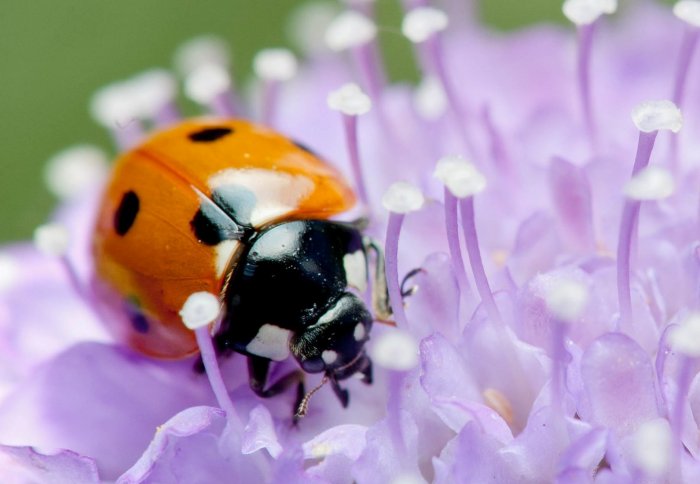
Many ladybird species are predators of crop pests. Photo: Lawrence Hudson

Species numbers have decreased where humans have altered the landscape by an average of 14 percent, affecting the functioning of major ecosystems.
This is one of the findings revealed today in a study published in Nature. The research shows how human caused land-use changes, such as the growth of agriculture, plantations and urban centres, have caused a global fall in the numbers of species found in local ecosystems.
The situation across large areas of Western Europe reflects some of the worst changes, with areas recording up to a 20-30 percent drop in species numbers. This could be disrupting the ‘ecosystem services’ we rely on nature to provide, such as air and water purification and sources for food and building materials.
These findings are a significant milestone in understanding our impact on the planet. They show that what happens next is completely down to us.
– Professor Andy Purvis
Most of these losses have come in the last 100 years, following the industrial revolution. If human impacts continue on the current trend, the study predicts another 3.4 percent loss in species globally by 2100. However, if practices change, and highly diverse forest ecosystems are given economic value to reflect their importance in reducing climate change, the last 50 years of losses could actually be reversed.
The new research is part of the Projecting Responses of Ecological Diversity In Changing Terrestrial Systems (PREDICTS) project. PREDICTS is a collaborative project involving the Natural History Museum, the United Nations Environment Programme World Conservation Monitoring Centre (UNEP-WCMC), and British universities including Imperial College London. It has so far collected data from 90 countries and 450 scientific papers, representing more than 40,000 species.
Undoing damage
Lead scientist Professor Andy Purvis, who is a Research Investigator in the Department of Life Sciences at Imperial College London and a Research Leader at the Natural History Museum, said: “These findings are a significant milestone in understanding our impact on the planet. They show that what happens next is completely down to us. If society takes concerted action, and reduces climate change by valuing forests properly, then by the end of the century we can undo the last 50 years of damage to biodiversity on land.”
The study compiled data from around the world to map the changes in biodiversity since the year 1500. Future changes were then projected based on several well-established scenarios of human behaviour and environmental change. These ranged from a ‘business as usual’ projection that predicted further losses, to a more optimistic scenario where losses were reversed under programs to value ecosystems.
Lead author of the study, Dr Tim Newbold of UNEP’s World Conservation Monitoring Centre, said: “The worst-case scenario we have mapped would have a devastating impact upon most regions of the planet. Our models predict that rapid agricultural expansion, particularly in poorer countries, will cause rapid further losses of biodiversity. However, other scenarios give a much more positive outcome for biodiversity, especially for poorer countries.”
First steps
Several of the authors of the new study fed into the project as part of their Masters studies, run jointly by Imperial and the Natural History Museum. Argyrios Choimes, who undertook the MSc in Taxonomy and Biodiversity and is now working as a conservationist, investigated the impact of human land-use changes on Mediterranean ecosystems.
“Overall, my research showed several effects on biodiversity,” said Choimes. “Most importantly, increase in land use intensity adversely affected the abundance of Mediterranean species, with urban sites showing decreased relative diversity in comparison to sites of primary vegetation.”
The PREDICTS database is in the process of being uploaded for use by researchers globally. It will contain data used in the present study as well as a wealth of information from other projects conducted by students during their studies. For example, Lucinda Kirkpatrick, who undertook the MRes in Biosystematics, looked at the impact of bush meat hunting on local diversity, and Melanie Edgar, who also gained an MRes in Biosystematics, investigated the traits and evolutionary relationships of beetles.
-
'Global land-use impacts on local terrestrial biodiversity' by Newbold et al. is published in Nature.
Supporters


Article text (excluding photos or graphics) available under an Attribution-NonCommercial-ShareAlike Creative Commons license.
Photos and graphics subject to third party copyright used with permission or © Imperial College London.
Reporter
Hayley Dunning
Communications Division

Contact details
Tel: +44 (0)20 7594 2412
Email: h.dunning@imperial.ac.uk
Show all stories by this author




Leave a comment
Your comment may be published, displaying your name as you provide it, unless you request otherwise. Your contact details will never be published.